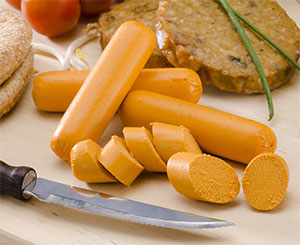Avoid the 2 Pitfalls of Vegetarian & Vegan Diets
When moving to a vegetarian or vegan diet, there are two very common pitfalls that can create just as many health issues as the standard American junk food diet. Newbies and long-term vegetarians alike often fall into these pitfalls due to a lack of education on how to healthfully eat vegetarian and vegan foods.
Ready to take the leap into the world of vegetarianism?
If so, first read...
 The vegetarian or vegan diet: Doing it right
The vegetarian or vegan diet: Doing it right  Popular myths of vegetarian & vegan diets
Popular myths of vegetarian & vegan diets
Next, pay careful attention to the following 2 pitfalls it can be easy to fall in to:
Pitfall #1 - Highly Processed Junk Food
Many vegetarians and vegans assume that meat and/or dairy products are the only offender in their old diet, and that by simply omitting these foods, they enter a healthy nirvana. But junk food vegetarians and vegans are just as common as junk food meat eaters. There are many overweight, unhealthy vegetarians and vegans living their own version of the American diet.
When we choose to eliminate animal products, but have little to no education on how to eat a balanced and healthy diet, it is very easy to fall prey to the many vegetarian and vegan foods in the supermarket that are highly processed and refined, and contain the same artificial chemicals as a meat eater's diet.
 |
Why processed soy is NOT a healthy food | |||
 |
Health dangers of eating processed soy |
|||
 |
GMOs & how they impact our health | |||
 |
The 8 myths of GMOs | |||
Pitfall #2 - Too Much Fat
 Many people assume that a vegetarian or vegan diet is much lower in fat than a meat eater's diet. In fact, the exact opposite is often true. Very similar to those on a raw food diet, when meat products are removed, they are often replaced by large amounts of high fat products such as:
Many people assume that a vegetarian or vegan diet is much lower in fat than a meat eater's diet. In fact, the exact opposite is often true. Very similar to those on a raw food diet, when meat products are removed, they are often replaced by large amounts of high fat products such as:
- Nuts
- Seeds
- Desserts & cookies
- Avocados and guacamole-based dips
- Liquid oils (especially coconut and flax seed)
- Nuts, nut milks, nut butters, nut dips
- Seeds, seed-based cheese, seed-based dips
Coupled with the fact that vegans often eat less food than meat eaters, yet more of the foods they eat are higher in fat, their overall percentage of fatty food intake increases significantly. Smoothies are filled with almond milk, flax seeds, and other exciting ingredients. A nut loaf averages over 80% fat. Vegans, especially raw food vegans, can easily tip the scale at 60-75% fat in their daily diet, significantly higher than their meat-eating counterparts.
What many vegetarians and vegans are unaware of is that just because it is vegetarian or vegan, does not mean that it is healthy to eat fat in mass quantity. I have had raw foodists, vegetarians, and vegans look at me in shock when we sat down and calculated their average daily fat intake to be over 70%, more than double the high-fat standard American diet. Such a high quantity of fat is not healthy and places not only a large strain on the digestive system, but can also cause us to feel sluggish and drained of energy.
Let's take a look at 2 simple examples of how healthy and naturally low fat foods can quickly be transformed into high-fat foods:
| Example 1 - Salad A simple salad with an array of vegetables and fruits starts off being naturally low in fat (on average under 7%). Add a tablespoon of flaxseeds here, a tablespoon of oil there, a big hunk of avocado, (it is common for some raw foodists to add all three in larger amounts)... and you suddenly arrive at 80% fat. These "harmless sprinklings" shift the fat scale dramatically. A popular blended raw dressing containing 2 tablespoons oil, 1/4 cup pine nuts, and 6 oz. avocado instantly turns a raw salad into 75%+ fat. Example 2 - Fruit Smoothie A simple smoothie of several fruits in water (or coconut water) with kale or Swiss chard is again under 7% fat. But many people use a base of nut milks, add coconut or flaxseed oils, nuts, and seeds... easily topping the 80% fat mark. |
Liquid Oils Are Not a Health Food!
Liquid fats are not health foods! They are products that have been extracted from their original whole food source and are now nothing but a 100% fat product with all other nutrients stripped. Fats should preferably be consumed as part of their original whole food, for example avocados, olives, nuts, and seeds eaten whole. Their nutrients are meant to be assimilated as a synergistic whole and, similar to supplements, they will not be the same once they have been extracted.
Liquid oils should only be consumed in VERY small quantities, if at all, and should be:
- Unrefined/cold-pressed, and organic if possible.
- Fruit, nut or seed-based oils such as olive oil, avocado oil, coconut oil, walnut oil, or sesame oil.
A Much Healthier Approach to Fat
On a vegetarian or vegan diet, knowing how much fat to eat, and from which sources is very simple:
- Eat a large variety of fruits and vegetables (at least 75%).
- Let the other healthy food items comprise 25% (legumes, sprouted grains, beans, and eggs/dairy if non-vegan).
- Healthy fatty foods are important, but should be up to 10% and be sourced from whole foods, which translates to:
- A handful of nuts, OR
- 1/3 to 1/2 medium avocado, OR
- 10 olives
If you are trying to gain weight, increase the higher fat foods up to 25%.
75% or more of your diet
Fruits & Vegetables
high water content / lighter / easy to digest
_______________
25% or less of your diet
Legumes, Nuts, Seeds, Eggs, Dairy
low water content / denser / more difficult to digest
(with a small quantity of high-quality fatty foods)




 This is especially so when it comes to meat and dairy substitutes that are made with processed soy. There is absolutely nothing healthy about the highly processed and genetically modified soy sludge of today. Traditional soy was fermented (e.g. tofu or tempeh) or eaten as a whole food (edamame), and was eaten in tiny quantities compared to the massive amounts eaten today.
This is especially so when it comes to meat and dairy substitutes that are made with processed soy. There is absolutely nothing healthy about the highly processed and genetically modified soy sludge of today. Traditional soy was fermented (e.g. tofu or tempeh) or eaten as a whole food (edamame), and was eaten in tiny quantities compared to the massive amounts eaten today.